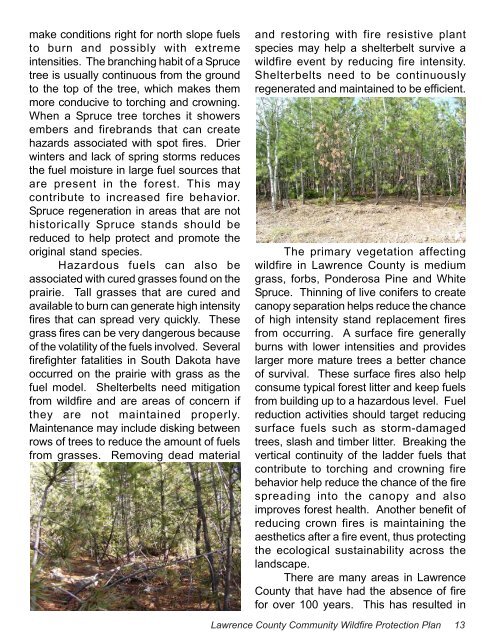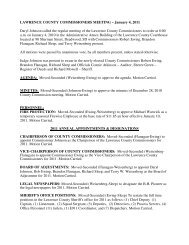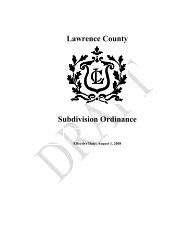Lawrence County Community Wildfire Protection Plan - Black Hills ...
Lawrence County Community Wildfire Protection Plan - Black Hills ...
Lawrence County Community Wildfire Protection Plan - Black Hills ...
Create successful ePaper yourself
Turn your PDF publications into a flip-book with our unique Google optimized e-Paper software.
make conditions right for north slope fuelsto burn and possibly with extremeintensities. The branching habit of a Sprucetree is usually continuous from the groundto the top of the tree, which makes themmore conducive to torching and crowning.When a Spruce tree torches it showersembers and firebrands that can createhazards associated with spot fires. Drierwinters and lack of spring storms reducesthe fuel moisture in large fuel sources thatare present in the forest. This maycontribute to increased fire behavior.Spruce regeneration in areas that are nothistorically Spruce stands should bereduced to help protect and promote theoriginal stand species.Hazardous fuels can also beassociated with cured grasses found on theprairie. Tall grasses that are cured andavailable to burn can generate high intensityfires that can spread very quickly. Thesegrass fires can be very dangerous becauseof the volatility of the fuels involved. Severalfirefighter fatalities in South Dakota haveoccurred on the prairie with grass as thefuel model. Shelterbelts need mitigationfrom wildfire and are areas of concern ifthey are not maintained properly.Maintenance may include disking betweenrows of trees to reduce the amount of fuelsfrom grasses. Removing dead materialand restoring with fire resistive plantspecies may help a shelterbelt survive awildfire event by reducing fire intensity.Shelterbelts need to be continuouslyregenerated and maintained to be efficient.The primary vegetation affectingwildfire in <strong>Lawrence</strong> <strong>County</strong> is mediumgrass, forbs, Ponderosa Pine and WhiteSpruce. Thinning of live conifers to createcanopy separation helps reduce the chanceof high intensity stand replacement firesfrom occurring. A surface fire generallyburns with lower intensities and provideslarger more mature trees a better chanceof survival. These surface fires also helpconsume typical forest litter and keep fuelsfrom building up to a hazardous level. Fuelreduction activities should target reducingsurface fuels such as storm-damagedtrees, slash and timber litter. Breaking thevertical continuity of the ladder fuels thatcontribute to torching and crowning firebehavior help reduce the chance of the firespreading into the canopy and alsoimproves forest health. Another benefit ofreducing crown fires is maintaining theaesthetics after a fire event, thus protectingthe ecological sustainability across thelandscape.There are many areas in <strong>Lawrence</strong><strong>County</strong> that have had the absence of firefor over 100 years. This has resulted in<strong>Lawrence</strong> <strong>County</strong> <strong>Community</strong> <strong>Wildfire</strong> <strong>Protection</strong> <strong>Plan</strong> 13





